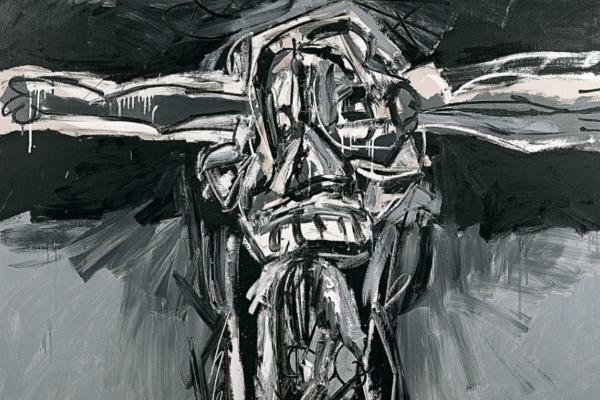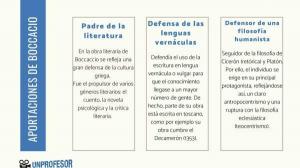Antonio Saura: most important works

Among the most important works of Antonio Saura are: 24 heads (1957), Crucifixion(1959), Imaginary portrait of Goya (1985) and Karl-Johann Strasse II(1997), works located in the Guggenheim Museum Bilbao. Antonio Saura (1930-1998) is a Spanish painter born in Huesca who is characterized by great expressiveness, his work being mostly figurative. Furthermore, Saura became obsessed with some themes, creating series such as those of nudes, self-portraits, shrouds, ladies, crucifixions, imaginary portraits, the history of Spain or his saurimachia.
In this lesson from unPROFESOR.com we present some of the most important works of Antonio Saura.
Index
- Main characteristics of the work of Antonio Saura
- 24 heads (1957), a sample of his series “Crowds”
- Crucifixion (1959-1963), one of the most impressive works Antonio Saura
- Imaginary Portrait of Goya (1985): Saura's fascination with Goya's work
- Karl-Johann Strasse II (1997), one of the last works of Antonio Saura
Main characteristics of the work of Antonio Saura.
Among the main characteristics of Antonio Saura's work that you need to know, we highlight:
- The work of Antonio Saura is very influenced by the aesthetics of two of the great masters of Spanish painting: Diego Velázquez and Francisco de Goya.
- Faced with the repressive cultural climate of the Franco era, Saura tried to free the Spanish artistic legacy from that environment and applied the most innovative and radical forms of Informal Art and Action painting North American to the most traditional Spanish themes. In this other lesson you can learn Action painting characteristics.
- Saura founded the El Paso group (1957-1960), a group whose objective was to promote the new forms of painting that were developing in the United States and Europe. At that time, his color palette was limited to black and white and he began to paint his famous series: the crucifixions, women, nudes, crowds, portraits and imaginary portraits.
- Saura also stands out for being a complete artist who not only dedicated himself to painting, but was also illustrator, writer, made engravings and set designer.
24 heads (1957), a sample of his series “Crowds”
This work by Antonio Saura is made on paper and has dimensions of 71x103.6x5.5 centimeters. A drawing showing the Saura's expertise as a draftsman, drawing being its main tool to explore the different variations of a motif or theme to study.
24 heads belongs to the series "Crowds", a series in which he dedicated himself from the late 1950s until his death. In this series, Saura shows us intertwined disembodied faces that occupy almost the entire surface of the canvas or paper. In this way, the painter creates large and complex compositions with heads of earth tones, also using collage in some of the works.

Image: Guggenheim-Bilbao
Crucifixion (1959-1963), one of Antonio Saura's most impressive works.
It is an oil painting on canvas, measuring 133x164.6 centimeters. This work is one of the most outstanding of the Crucifixions series. This theme also accompanied Saura until his death. A frenetic work in which the painter takes as a model the Crucifixion by Velázquez and reinterprets it in a way full of strength and intensity, following modern trends and trying to open a debate about that Christian symbol.
A symbol that becomes a whole in Saura's work. emblem of the tragedy of the human condition. Thus, the work is an artistic and political protest against the violence and tensions that were experienced in those decades. It is not a religious work that tries to give a new version of this episode in the life of Jesus Christ but rather the pain and suffering of a person.

Image: Guggenheim-Bilbao
Imaginary Portrait of Goya (1985): Saura's fascination with Goya's work.
This is a work done in mixed technique on paper and has dimensions of 83.5x125x5.5 centimeters. Saura, fascinated by the black paintings by Goya, he makes this portrait in which he shows us Goya contemplating reality, trying to show that moment of emergence or birth of the artistic work and the states of mind that accompany that moment.
For this work, Saura is inspired by the work half-sunken dog, a very enigmatic piece by Goya in which he represents the head of a dog emerging from a pile of earth. From there, the painter created a series of portraits and, among them, the Imaginary portrait of Goya, a painting in which emptiness occupies most of the composition, emptiness being an important element prior to creation.

Image: Guggenheim-Bilbao
Karl-Johann Strasse II (1997), one of Antonio Saura's last works.
This work is a oil on canvas and constitutes the most monumental work of the painter. Specifically, Karl-Johann Strasse II is a work that he painted before his death and that is part of the series "Crowds". This work is inspired by a painting by Munch, Sunset on the Karl-Johann Promenade in Oslo(1892). A work in which you can see a group of people walking through the city with faces that resemble masks.
Saura paints a concentrated mass of heads with very marked features that look like a kind of wall built with Cyclopean stones or even skulls stacked in an ossuary. The painter tries to show us bodiless faces coordinated in a dynamic way as if they were something organic. In this series the influence of Jackson Pollock and of the works of Goya and James Ensor.
Now that you know the great artist Antonio Saura better, we recommend you read this other lesson on Jackson Pollock: most important works.

Image: Guggenheim-Bilbao
If you want to read more articles similar to Antonio Saura: most important works, we recommend that you enter our category of History.
Bibliography
- GARCÍA-PERERA, José-Manuel. Antonio Saura and the destructive gaze. The monster beneath us. Bulletin of the Camón Aznar Museum and Institute of Ibercaja, 115, 127-154., 2017.
- GIMENO, Félix Ferrer. Theory and informalist aesthetics of Antonio Saura Atarés. Argensola: Magazine of Social Sciences of the Alto Aragonese Studies Institute, 1960, no 41, p. 63-70.
- SAURA, Antonio OP. Antonio Saura: 1930-1998. Astragalus: Culture of Architecture and the City, 11, 116-116., 1999.
- ZORRILLA, Virginia. Antonio Saura: The painter of rupture. Cambio 16, 1998, no 1393, p. 64-65.



